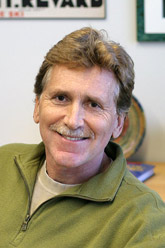
Handy Links
SLAC News Center
SLAC Today
- Subscribe
- Archives: Feb 2006-May 20, 2011
- Archives: May 23, 2011 and later
- Submit Feedback or Story Ideas
- About SLAC Today
SLAC News
Lab News
- Interactions
- Lightsources.org
- ILC NewsLine
- Int'l Science Grid This Week
- Fermilab Today
- Berkeley Lab News
- @brookhaven TODAY
- DOE Pulse
- CERN Courier
- DESY inForm
- US / LHC
SLAC Links
- Emergency
- Safety
- Policy Repository
- Site Entry Form

- Site Maps
- M & O Review
- Computing Status & Calendar
- SLAC Colloquium
- SLACspeak
- SLACspace
- SLAC Logo
- Café Menu
- Flea Market
- Web E-mail
- Marguerite Shuttle
- Discount Commuter Passes
-
Award Reporting Form
- SPIRES
- SciDoc
- Activity Groups
- Library
Stanford
Around the Bay
From the Director of SSRL: A Glimpse of SSRL's Future

In my last column, I talked about the Stanford Synchrotron Radiation Lightsource's enduring status as a "top notch" X-ray user facility and promised to tell you how it plans to rejuvenate itself in the future. In the meantime, I have accepted the position of Linac Coherent Light Source Director. You may ask where this leaves my promised story. Not to worry, in this, my last column as SSRL Director, I will give you my vision of SSRL's future. If we fast-forward a decade, you may be surprised to find SSRL in the limelight!
Clearly the eyes of the X-ray world are presently on LCLS due to its spectacular early success of producing a lasing X-ray beam and the upcoming first X-ray experiments in September. I expect LCLS to remain in the spotlight for well over a decade, with additional expansions of its early capabilities, facilities and revolutionary discoveries. But extending the horizon, say to ten to fifteen years, I see major opportunities for growth at SSRL. There are several reasons for this likely development.
In a December 2008 briefing paper of the incoming Obama administration, the four Department of Energy-funded X-ray facilities in the US—the Advanced Light Source, Advanced Photon Source, National Synchrotron Light Source and SSRL—produced a joint vision paper entitled "Science and Technology of Future Light Sources." This paper discusses the broader scientific challenges before us, including those in the major areas of energy, environment, health and technology, and focuses on the role X-rays can play in addressing them. It specifically looks at the types of future X-ray sources needed and comes to the conclusion that the nation's scientific needs will not be entirely met by the current ALS, APS, NSLS and SSRL facilities or even the LCLS and NSLS-II facilities under construction. It also emphasizes the need for two generic types of complementary X-ray sources based on linear accelerators and rings, respectively. The report therefore opens the door for a new X-ray facility at SLAC, which will be built after LCLS and its envisioned upgrades. This complementary ring based light source, PEP-X, takes advantage of the existing PEP tunnel, accelerator components and infrastructure and will replace SPEAR3. It will provide the SSRL user program with the leading ring based X-ray source in the world.
Operated either as a very low emittance storage ring or in conjunction with an energy recovery linac, PEP-X has already been incorporated as a key component into SLAC's long term strategic plan. The combination of LCLS and PEP-X, in conjunction with SLAC/Stanford science programs that utilize these facilities, promises to make SLAC the world's leading photon science laboratory. Since both facilities are based on large accelerators, they are not only enabled by SLAC's strength in accelerator science and technology but more broadly help maintain accelerator science as a key core competency and capability of the lab, in good accord with the continued use of the word "accelerator" in the lab's new name.
Toward the PEP-X goal, the SSRL Scientific Advisory Committee has recently recommended that future instrumentation and science programs be established in preparation for the greatly enhanced PEP-X brightness, and that new beam lines, if possible, be planned to be transferable to PEP-X. While the 10–15 year period toward the new source may appear daunting, experience with the planning and construction of new light sources has shown this to be quite a normal timeframe. After all, LCLS was first proposed seventeen years ago. Great things take time…
